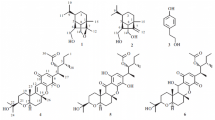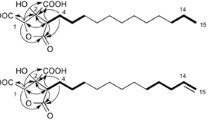From the branch tissue of Cephalotaxus mannii, the endophytic fungal strain CMM was isolated and determined to belong to the genus Aspergillus according to its internal transcribed spacer (ITS) sequence of rDNA (ITS1-5.8S-ITS2). From the extracts of the fermentation broth of CMM, a new compound, namely 5-O-α-D-glucopyranosyl-5-hydroxymellein (1), was isolated, together with a known compound 4-hydroxymellein (2). Their structures were elucidated on the basis of 1D and 2D NMR data.
Similar content being viewed by others
Explore related subjects
Discover the latest articles, news and stories from top researchers in related subjects.Avoid common mistakes on your manuscript.
Endophytic fungi are found in almost all plants and have been shown to be a rich source of biologically active metabolites [1]. Cephalotaxus mannii, an important medicinal plant widely distributed in southern Asia, contains harringtonine and related cytotoxic substances [2]. During our search for new bioactive natural products from the endophytic microorganisms, a series of compounds has been isolated [3, 4]. In continuing our studies, we investigated the secondary metabolites produced by the fungal strain CMM isolated from the sterilized twigs of C. mannii. In this work, we report the isolation and structure elucidation of 5-O-α-D-glucopyranosyl-5-hydroxymellein (1) and 4-hydroxymellein (2), which were obtained by chromatographic purification of the extracts from the fermentation products of the fungal strain CMM.
Compound 1 was obtained as a colorless crystal. The molecular formula of 1 was determined to be C16H20O9 by analysis of the NMR spectroscopic data and ESI-MS measurement of the quasi-molecular ion at m/z 379.2 [M+Na]+. Inspection of the 1H and 13C NMR, HMQC, and HMBC data (Table 1) determined the structure of 1 as 5-O-α-D-glucopyranosyl-5-hydroxymellein. The 1H NMR spectra of 1 exhibited signals for dihydroisocoumarin lactone at δ 4.74 (m), 2.79 (m) and 3.83 (m) assigned to H-3 and H2-4, respectively (Table 1) [5–7]. Two aromatic protons at δ 6.83 (d, J = 9.1) and 7.49 (d, J = 9.3), seven sugar protons at δ 5.34 (d, J = 3.2), 3.59 (dd, J = 3.3, 9.8), 3.72 (t, J = 9.8), 3.83 (m), 3.41 (m) 3.80 (m) and 3.69 (m), and a methyl group at δ 1.52 (d, J = 6.2) were observed as well.

The 13C NMR spectral signals at δ 101.0, 73.4, 74.9, 75.0, 71.2, and 62.6 and an anomeric proton at δ 5.34 (d, J = 3.2) in the 1H NMR spectra suggested the presence of an α-D-glucopyranosyl moiety in 1. Besides the signals for the α-D-glucopyranosyl moiety, the 13C NMR and DEPT spectra further revealed the presence of a C10-unit including one methyl, one methylene, three methines, and five quaternary carbons. In the HMBC spectra, the proton at δ 6.83 (H-6) showed 1H–13C long-range correlations to C-10 and C-8, 7.49 (H-7) to C-5, C-8, and C-9, and the methylene protons (at δ 3.83 and 2.79) to C-11, C-3, C-9, C-10, and C-5, indicating the presence of a dihydroisocoumarin moiety. The attachment site of the glucose unit was indicated by the 1H–13C long-range correlation between the anomeric proton at δ 5.34 and C-5 (δ 147.1) in the HMBC spectra. Therefore, compound 1 was determined to be 5-O-α-D-glucopyranosyl-5-hydroxymellein.
Compound 2 was obtained as a colorless crystal. The molecular formula of 2 was determined to be C10H10O4 by analysis of the NMR spectroscopic data and ESI-MS measurement of the quasi-molecular ion at m/z 195.1 [M+H]+. Inspection of the 1H NMR, 13C NMR, and DEPT spectra revealed 10 carbon signals for one methyl, five methines, and four quaternary carbons, including one carbonyl at δ 171.0 (C-1). The 1H NMR showed three olefinic protons at δ 7.56 (t, 8.1) and 6.98 (d, 8.1, 2H). Comparison of the proton and carbon NMR signals of 2 with those of mellein [8, 9] indicated that 2 is a derivative of dihydroisocoumarin. The hydroxyl group at C-4 was confirmed by the low-field shift of the carbon at δ 67.7 and the proton at δ 4.56 (H-4). The HMBC and 1H–1H COSY further supported this substitution. Therefore, compound 2 was determined to be 4-hydroxymellein [10].
Experimental
General Experimental Procedures. Column chromatography (CC): silica gel (200–300) mesh; Qingdao Marine Chemical Factory, Qingdao, P. R. China), silica gel GF254 (Merck), RP-18 (Merck), and Sephadex LH-20 (Amersham Biosciences) were used. TLC: precoated silica gel GF254 plates (0.20–0.25 mm, Qingdao Marine Chemical Factory). 1H and 13C NMR spectra: Bruker DRX-500 spectrometer, at 500/125 MHz, in MeOD; δ in ppm rel. to Me4Si, J in Hz. ESI-MS: Thermo-Finnigan Advantage LCQ mass spectrometer; in m/z.
Microbial Material. Branches of Cephalotaxus mannii collected at Xishuangbanna (Yunnan Province, P. R. China) in March 2004. The material was washed under running tap water, then sterilized successively with 75% aq. EtOH (1 min) and 1.2% sodium hypochlorite (8 min), and then rinsed with sterile H2O. The sterilized plant material was cut into small pieces and incubated at 28°C on PDA medium. During cultivation, the hyphal tips of the growing fungi were removed and inoculated onto fresh PDA media and incubated for at least two weeks at 28°C. After being purified by the hyphal tip method [11], the pure isolates were transferred to PDA slant tubes as deposit. The strain CMM was inoculated on a slope of PDA media in a test tube and cultivated for 5 d at 25°C to afford seed cultures. Solid-state fermentation was performed with PDA media for 10 days at 28°C.
The CMM strain was identified by amplification of the ITS sequence of rDNA (ITS1-5.8S-ITS2), and its sequence was submitted to GenBank (accession No.EF62400). Blast search showed that the sequence of CMM was highly homologous to other Aspergillus species, indicating that this strain is a member of the genus Aspergillus.
Extraction and Isolation. The fungal strain Aspergillus sp. CMM, was cultured on PDA media (10 L) for 10 days. The culture was extracted three times with an equal volume of AcOEt–MeOH–AcOH 80:15:5 (v/v/v) at room temperature. The organic solutions were collected by filtration and removed under vacuum at 40°C to yield the crude extract (19.5 g).
The extract was subjected to MPLC (170 g RP-18) and eluted with H2O and 30, 50, 70, and 100% MeOH (1.5 L each) to yield 5 fractions: Fr. D1–D5. Fraction D2 (2.02 g) was subjected to CC (140 g Sephadex LH-20; MeOH). All fractions were analyzed by TLC (CHCl3–MeOH 10:1) and pooled accordingly into eleven portions (Fr. D21–D211). Fraction D24 (190 mg) was subjected to CC (40 g Sephadex LH-20; MeOH) to afford D24a (172 mg). Fraction D24a was subjected to CC (7 g SiO2; CHCl3–MeOH 50:1, 10:1) to afford 1 (5 mg). Fraction D25 (400 mg) was subjected to CC (40 g Sephadex LH-20; MeOH) to afford D25a (370 mg). Fraction D25a was subjected to CC (9 g SiO2; CHCl3–MeOH 50:1, 20:1, 10:1) to afford 2 (30 mg).
References
R. X. Tan and W. X. Zou, Nat. Prod. Rep., 18, 448 (2001).
I. Takano, I. Yasuda, M. Nishjima, Y. Hitotsuyanagi, K. Takeya, and H. Itokawa, Phytochemistry, 43, 299 (1996).
C.-H. Lu, Y.-J. Huang, and Y.-M. Shen, Chin. J. Nat. Med., 3, 269 (2005).
C.-H. Lu and Y.-M. Shen, J. Antibiotics, 57, 597 (2004).
Y. M. Bi, X. B. Bi, Q. R. Zhao, A. Fang, and Y. G. Chen, Pol. J. Chem., 80, 397 (2006).
M. S. Ansari, N. H. Rama, A. Saeed, C. W. Bird, and M. T. Hussain, J. Ind. Chem. Soc., 77, 39 (2000).
B. V. McInerney and W. C. Taylor, Stud. Nat. Prod. Chem., 15, 381 (1995).
G. S. Hirschman, E. Hormazabal, L. Astudilo, J. Rodriguez, and C. Theoduloz, World J. Microbiol. Biotechnol., 21, 27 (2005).
K. Krohn, R. Bahramsari, U. Flsrke, K. Ludewig, C. Klichespory, A. Michel, R. Aust, S. Draeger, B. Schulz, and S. N. Antust, Phytochemistry, 45, 313 (1997).
P. Venkatasubbalah and W. S. Chilton, J. Nat. Ptod., 53, 1628 (1990).
G. Strobel, X.-S. Yang, J. Sears, R. Kramer, R. S. Sidhu, and W. M. Hess, Microbiology, 142, 435 (1996).
Acknowledgment
This work was financially supported by the National Natural Science Foundation of China (30500632), the National Science Fund for Distinguished Young Scholars to Y.-M. Shen (30325044), and the Key Grant of the Chinese Ministry of Education (No. 306010).
Author information
Authors and Affiliations
Corresponding author
Additional information
Published in Khimiya Prirodnykh Soedinenii, No. 5, pp. 461–462, September-October, 2008.
Rights and permissions
About this article
Cite this article
Lu, C., Lin, X. & Shen, Y. A new dihydroisocoumarin from the strain Aspergillus sp. CMM, an endophytic fungus of Cephalotaxus mannii . Chem Nat Compd 44, 569–571 (2008). https://doi.org/10.1007/s10600-008-9146-4
Received:
Published:
Issue Date:
DOI: https://doi.org/10.1007/s10600-008-9146-4




